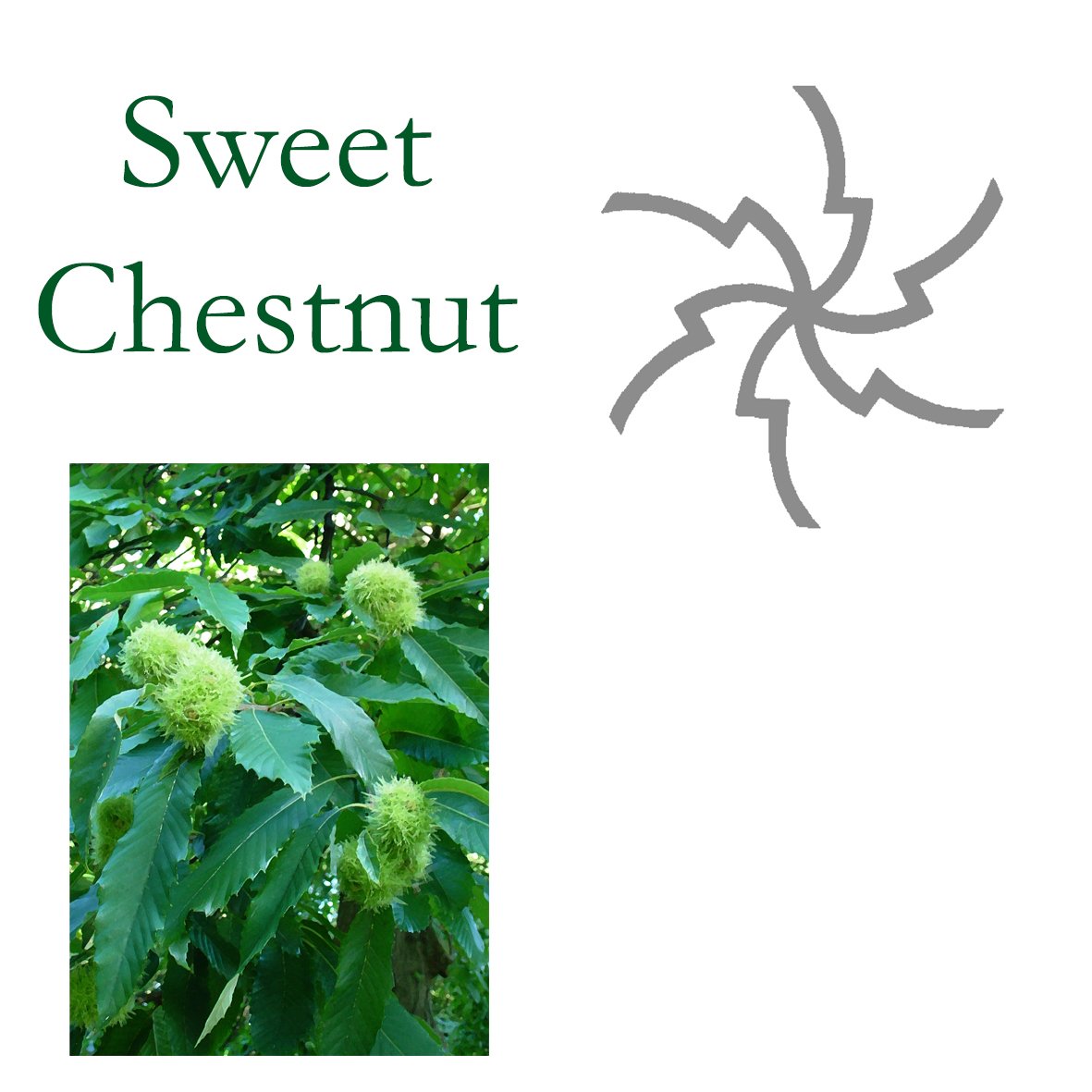SWEET CHESTNUT (Castanea sativa)
Key: The Now
Sweet chestnut, or Spanish chestnut, grows wild in southern Europe, North Africa and the Near East. It is particularly common in Spain. It was possibly brought to Britain by the Romans – its fruits are the edible chestnuts traditionally roasted in winter. Sweet chestnut is one of the largest broad-leaved trees in the land, though it does not germinate easily in the cooler British climate. It is a very fast-growing tree and can live for a long time. The tree grows tall and narrow with low branches that spread the crown wider with age. It can grow to 100ft. The larger trees develop a noticeable spiral twist in the bark. Male catkins appear in long yellow tassels in summer at the tips of the branches and the smaller green, rounded female flowers can be found near the leaf bases. The leaves are long, narrow and glossy green with saw-toothed edges. The fruits develop into paired nuts within a green prickly shell.
With sweet chestnut spirit there comes an intuitive understanding of underlying harmony and balance. It becomes easier to communicate hidden emotions and feelings in a clear way. This allows deep peace into the heart and emotions. This essence also creates a detached space that enables one to regain the understanding that comes from a wider perspective.
Central and Heart meridians are balanced and this re-establishes centreing, focus and respect for the self.
There is a release of stress, shock and trauma that allows creativity to flourish in a way that expresses the individual energy pattern. This can profoundly affect healing and growth on spiritual levels.
The brow chakra becomes better able to function, which makes it easier to formulate strategies and find creative ways out of difficult situations.
All the subtle bodies become more integrated and there is an increased confidence in the physical body, improving the sense of well-being. Validation of physical existence in this way helps to remove any sense of guilt and clarifies the personal awareness of right and wrong.
Sweet chestnut helps to release this deep guilt particularly where it focuses on a lack of love for physical existence, physicality itself, strong passions and desires and anything “earthy”. It can be especially useful for those who feel uncomfortable about physicality as being “unspiritual”. It encourages the truth that the physical is holy and not a “mistake”. The essence also helps to bring the ability to accept change on the physical plane and creates a doorway whereby cosmic and universal loving energies can enter the physical system.
At the very finest level sweet chestnut brings love to all actions. There is an increase in confidence, peace and inner tranquillity. A space is created in the present for healing and love and protection against aggression.
Signature: The uncomfortable prickly case contains the sweet fruit: the joy and bliss within the apparent discomfort of physical form.
Comment: Sweet chestnut is among the oldest and largest living creatures in this land. A tree at Tortworth church in Gloucestershire is possibly the oldest with claims that it was planted in the reign of King Egbert who died in 839. It was certainly recorded as a very large tree in the 12th century and now has two massive branches lying along the ground that have sent up smaller trees or branches that appear to be layers from the original bole.
Edward Bach suggested that sweet chestnut be used for those who suffer unendurable anguish and face destruction and annihilation.
Sweet chestnut wood, when young, provides excellent timber with very little sapwood. It can be used to take the place of oak, and will last better than oak where it is under the ground. The leaves are picked in summer and dried or used fresh for convulsive coughs, such as whooping cough, and in other conditions where the lung tissues are irritated. It is astringent and tonic.

